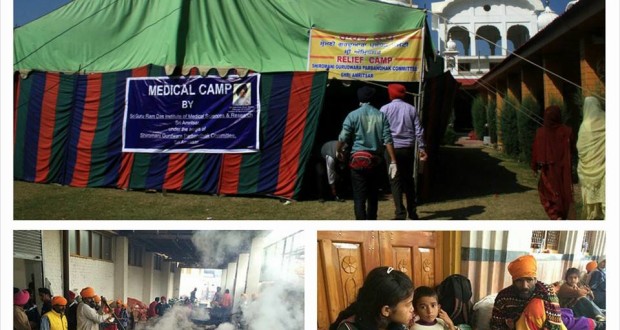SriNagar, India: A relief camp started by Kashmiri Sikhs a day before deluge hit Srinagar inside a Gurduwara in uptown Srinagar provided timely rescue and relief to thousands of flood-ravaged people. Three weeks after, the camp is still busy providing relief to an unending rush of flood-hit.
Scores of women have fallen in line inside Gurduwara Shaheed Bunga Bhaghat (GSBB) in uptown Srinagar. These flood-ravaged females are mostly Muslims. The deluge devoured their homes, turned their stuff into slush and left behind a putrefying stench.
One by one, they come forward and receive the relief material from the camp run by local Sikh brethren inside the vicinity of the Gurduwara.
Gurduwara offers myriad scenes. Harmony co-exists with confusion—mainly reflecting from the faces of flood-hit. People keep pouring endlessly at the place. After five exits with relief material, another ten falls in line. Standing in a queue, women appear absorbed. They appear absent-minded.
In contrast, the relief workers appear active. They are tirelessly distributing the relief material among the flood-hit.
After the floods hit Kashmir, relief camps started cropping up in many parts of valley. By September 6, a day before the deluge put life out of gear in summer capital, a rescue-cum-relief camp was started inside GSBB. Since then flood-hit people are continuously pouring at the camp.
GSBB becomes what its volunteers are calling the “central relief committee” for anyone coming forth. More than one lakh flood-hit people have so far visited the camp, says the camp public relations officer Bikram Singh, “besides, the camp provided medical treatment to more than 20,000 people.” While receiving a torrent of people at the camp, Bikram says, the camp supplied medicines to hospitals like SKIMS and to other medical camps.
The camp is managed by Gurduwara Prabandhak Committee Budgam. Bikram Singh says, after focussing on rescue works, the camp concentrated on relief and medical facility. And once done with the relief works, he says, the camp will be working on rehabilitation process.
“Our relief distribution is very much systematic,” he says. “Every victim or victimised families were given relief as per their needs. No one was given much or less.”
After a while, the rush at the camp derails Singh’s briefing. He along with camp team is now busy attending the people. And meanwhile, the scenes at the camp appear intriguing. On the right side of the entrance, a prominent Kashmiri dramatist and film maker, Arshad Mushtaq is playing with a bunch of kids. Those who are catching glimpse of the dramatist encircled by kids are passing smiles. This part of the lawn is in serious contrast with the camp where anxious flood-hit people seem reflecting remorse.
Running the camp (where emotions run high) nonstop for three weeks was beyond individual’s capacity. The long run was made possible by Sikh volunteers who offered their services from the very beginning.
During rescue operations, three hundred volunteers including locals and non-state subjects have turned up with help at the camp. Special rafters were called in from mainland India, which put more than 300 volunteers on their toes. These volunteers went everywhere to rescue the stranded people. Besides community based kitchen was setup inside GSBB on war-footing to cater a large chunk of flood-displaced population. These kitchens are continuously feeding people, especially those who have been sheltering inside Gurduwara after losing their homes to flood fury.
The flood-displaced people are packed inside a spacious hall of Gurduwara on the first floor. They look weary, lost and worried. Some of them are sleeping. A few are still sobbing over their loss. Others are busy talking. Girls are busy in making their hair plaits. Boys are roaming around.
Next is the room of management team and planning staff. They are busy in accounting available and required stock.
After the flood, many heroes and their heroics are feeding main headlines to Press. One such hero is a resident of Jawahar Nagar, Satnam Singh.
Satnam Singh’s nephew, Manjeet Singh while recalling the heroics of his uncle says, his heroics not only saved his family, but scores others.
Satnam, Manjeet Singh says, made smart use of his turban and saved many lives by holding himself one part of the turban and accordingly the other part was held by the stranded people to come out of the troubled waters.
“In hard times, our turban, our pride, came to our rescue,” says Manjeet Singh, a resident of Alouchi Bagh. “It was Wahe Guru’s blessings that made my uncle to make use of his turban on the right occasion for saving many precious lives.”
Manjeet Singh was himself trapped in his home for three days. Next to his home was a building, under construction, where a cow and its little calf were trapped. “I somehow managed to make way into that very building and evacuated the cattle,” says Manjeet.
The camp receives six truckloads of relief material on an average daily. And 900 trucks of relief are on its way, says Bikram SIngh.
“Family packages are prepared by the management team according to the need from fully damaged and partially damaged houses,” he says. “Raw food is supplied continuously including rice and flour.” Moreover, he says, the personal needs of women and babies are taken care of.
As people replace the state by playing a major role in rescue and relief, the community sense has also strengthened. This is exactly what Bikram remarks on parting note: “We Kashmiris have always stood for each other cutting across the religious lines. This calamity fell on everybody. Nobody is untouched. But we are survivors. And we will survive the flood fury as well!”
Source: SikhChannel.Com
 Sikh Sangat News Celebrating Sikh culture and sharing Sikh voices
Sikh Sangat News Celebrating Sikh culture and sharing Sikh voices

